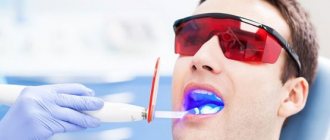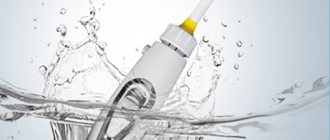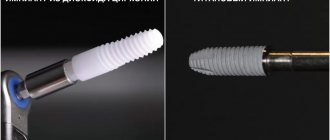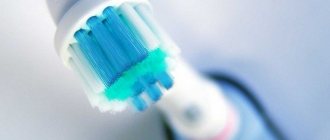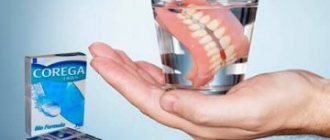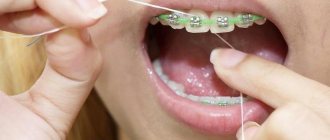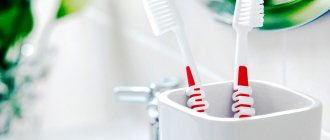Brushing your teeth after installing braces becomes more difficult. Residues of food stuck between parts of the structure cannot be removed by brushing, flossing or rinsing. This problem can be solved through daily use of an irrigator. We'll tell you which device is better to choose and how to use it when caring for braces.
In this article
- What types of irrigators are there?
- Irrigators for braces: orthodontic attachments
- Irrigator for braces - how to choose
- Rating of the best irrigators for caring for braces
- How to use a irrigator to clean braces
Braces are complex metal structures consisting of many small parts. They are placed on teeth to change their position. These orthodontic devices are non-removable. They cannot be removed before going to bed or after eating to clean and rinse. Oral care becomes more difficult. However, neglecting hygiene is dangerous. There is a risk that plaque will begin to form under the braces or carious lesions will appear. A large amount of food accumulates behind the structural elements, which cannot be removed with a regular brush. Special brushes and threads allow you to cope with this problem, but they take a lot of time. It is much faster to get your braces in order by cleaning them from food debris with an irrigator.
Oral cleaning devices are available with various attachments: standard, tongue, massage, periodontal and orthodontic. Let's try to figure out which irrigator is best to use for braces. First, let's talk about the main features of these devices.
Operating principle of the irrigator
Due to the operation of the motor, a stream of water under a certain pressure is supplied from the reservoir through the nozzle. Modern devices are not limited to supplying a conventional mono-jet of liquid - it can be pulsating and of varying strength (switched by buttons). This allows all family members to use the device, as well as select a specific mode depending on the condition of the gums and teeth in the mouth.
When using an irrigator, you do not need to add any products - only water is enough for high-quality cleansing, but you should use a rinse aid after the hygiene procedure.
What attachments must be included in the kit to clean braces?
The device for cleaning braces comes with various types of attachments. Each of them has its own purpose.
Standard – small hole and smoothly curved neck. Covers 1-2 teeth. Does a good job of cleaning braces.
It is worth noting! The orthodontic nozzle cleans all types of structures, including braces.
Sanitizes interdental areas and joints between teeth and gums. The neck has a narrowed tip and the tube is elongated. The pressure is strong, the stream is thin.
Massage – the nozzle is equipped with bristles, the head is rounded. Regenerates the mucous tissues of the oral cavity after surgical interventions, relieves pain, improves blood circulation.
Makes getting used to the corrective device quicker and less painful.
Periodontal – a nozzle with elastic bristles.
With its help, the liquid penetrates into the periodontal pockets and beyond the gingival margin, carefully cleaning plaque from the teeth and braces.
How to choose an irrigator: useful tips
A standard irrigator consists of the following components: a handle holder, a water tank with a lid, a battery, a charger and a set of nozzles. For ease of use, the device is equipped with control buttons: removing/fixing the tip, turning it on/off, adjusting the pressure.
Stationary and compact irrigator
There are two types of irrigators: stationary, which are large in size and connected to power via an outlet, and compact - they are small in size and run on batteries or a rechargeable battery. When choosing a device, it is recommended to give preference to the second type - it can be used even where there is no outlet, you do not depend on the length of the wire, and a small water tank is enough for one teeth cleaning procedure. In addition, you can always take it with you on a business trip or travel.
Battery type
Modern irrigators operate either from the mains or from a battery. It is better if the device is equipped not with batteries, but with a rechargeable battery - in this case, you can quickly recharge it. As a rule, it takes several hours to fully charge, so as soon as the device signals that there is no power, try to connect it to power overnight - this way you won’t miss another hygiene routine.
Device weight
It is best to choose devices that are light in weight - when performing hygiene, it will be easy and convenient to hold in your hands.
Number of nozzles
Even the most inexpensive models of irrigators have at least 2 nozzles - as a rule, they do not fail, so several family members can use the device at once. This is a significant plus. Some devices even come with colored attachments, allowing you to choose your own color.
Number of modes
There should be at least two of them: weak and strong - in this case you can choose the most optimal one for yourself, depending on the condition of your gums. Otherwise, too little pressure may not be effective; too much pressure will result in injury to the mucous membranes. In addition, if you have braces, it is recommended to use low pressure, which will allow you to clean hard-to-reach spaces, but will not lead to the braces coming off.
Some models of irrigators have special nasal attachments. They are effectively used to rinse the nasal cavity for rhinitis and sinusitis.
TOP models
Important! For comprehensive oral care, you need to choose a good irrigator.
We invite you to familiarize yourself with the rating of the best devices in terms of price and quality:
- Oral-B Professional Care Oxy Jet MD-20 . Smoothly adjustable jet power, large tank, four nozzles included. Circular spray mode, affordable price.
- Shenzhen Fortunecome Technology FL-V8 . Stepwise adjustment of jet pressure, three modes, two nozzles included. Charging via cable.
- Panasonic EW 1211 A. Multi-bubble technology, three modes. Wireless charging, compact.
- Device WaterPik WP-660 Aquarius Professional . Has two modes, powerful jet pressure. There are 7 nozzles and a large volume of water tank. Speed control is smooth, the nozzle rotates 360 degrees, safe to use.
- Philips AirFloss Ultra HX8432 . Spacious container for water or rinse aid, built-in battery. Injection function and spray mode, ergonomic design, power.
- Irrigator Donfeel OR-840 AIR. There are 4 attachments (orthodontic, jet, periodontal, tongue cleaning), 10 modes. Magnetic innovative attachment attachment. Quiet in operation.
- Device AQUAJET LD-A8 . Has 5 nozzles included, smooth speed control. It is compact and inexpensive.
Keep in mind! This device is not a replacement for floss and toothbrushes, but an additional tool for professional oral hygiene.
Rules for using the device
One of the advantages of the irrigator is its ease of use. The sequence of actions when cleaning braces, teeth and gums should be as follows:
- warm water is filled into the tank,
- the required mode is selected: it is better to start with minimum power and then increase to the desired parameters,
- the nozzle is brought to the teeth at an angle of 45 degrees and the water supply is turned on,
- the entire space of braces, teeth and gums is processed - on average, all hygiene should take about 2-3 minutes,
- After brushing your teeth, you must rinse your mouth with an antiseptic solution.
The optimal frequency of use of the irrigator is twice a day, morning and evening. More frequent use is possible - if you have braces, cleaning can also be done after every meal for better cleaning of hard-to-reach areas.
Why is braces care so important?
Braces fit closely to the teeth, which leads to the rapid accumulation of bacteria in these places. Pieces of food easily get stuck between structural elements. Viscous and sweet foods stuck to the surface of braces can cause very rapid development of caries. Therefore, you need to pay special attention to cleaning braces.
Patient reviews
“The doctor forbade me to use the irrigator - I had ceramic braces, he said that they would come off on me. And I read on the forums more than once that people use it. But I didn’t risk it..."
Irina P., 26 years old, Moscow
“The irrigator became my salvation!!! Cleaning braces is just some kind of hell, you can’t get anywhere. I purchased the device long before installing the bracket system, because... I had problems with my gums. I used it after every meal - I walked quickly, knocked the food out from under my braces and no brushes were needed. Very comfortably"
Marina Nikolaeva, Volgograd
Is it necessary if a teeth straightening system is installed?
Patients who have installed braces are required to receive a doctor's recommendation to use an irrigator in addition to regular daily brushing. Why is this so important:
- the stream of water jet cleans the places where braces join the tooth enamel, as well as the spaces under brackets and arches;
- the structure lock is thoroughly cleaned;
- adjustable jet pressure allows you to carefully clean ceramic braces;
- In terms of its functionality, the irrigator can replace the combined use of floss and a dental brush.
Attention ! Cleansing with an irrigator is used immediately after brushing with a toothbrush. After using dental floss, it is not advisable to immediately use an irrigator, because if the floss injures the gums, then a tight water jet can aggravate the problem.
To care for braces, you should try to use the irrigator after every meal. For these purposes, the device has a special attachment, which must be purchased separately.
How to use an irrigator to clean teeth with braces:
- The reservoir of the device is filled with filtered water, and it is possible to add prophylactic solutions for mouth rinsing or decoctions of medicinal herbs. The solution must be free of impurities and at room temperature.
- Leaning over the sink, slightly open your mouth.
- A stream of water is directed onto the teeth, gums, interdental spaces, starting with the last molars.
- Carefully treat each bracket lock and its connection with tooth enamel.
- After this, massage the gum line.
- Lastly, clean the tongue and other surfaces.
Benefits of use
Some models of irrigators can be quite expensive, but their purchase is completely justified and pays for itself, since their use gives the owner the following advantages:
- high-quality cleaning of any, even the most inaccessible places;
- An irrigator for braces eliminates the problem of poor mouth cleaning and the threat of an unpleasant odor;
- increases oral protection against various diseases, including caries, tartar formation and gum problems;
- makes it possible to improve the condition of the gums with the help of a massage;
- allows for proper care of dentures and implants.
Instructions for use
In order to use the device, it must first be prepared. For this purpose, the water container is filled with warm liquid that does not contain impurities; if we are talking about the first use, then cleaning is needed on a more serious scale, in particular, water is passed through the nozzle in normal operation.
The procedure itself is performed in several steps:
- the nozzle is directed to the dentition, starting from those teeth that are located further;
- cleaning is performed for each bracket; clasps and elements adjacent to the enamel deserve special attention;
- then the jet is directed to the tooth spaces and gum line;
- The cleaning is completed by treating the remaining surfaces.
After completing the procedure, the container of the apparatus is emptied of water and thoroughly dried.
conclusions
When choosing an irrigator, you need to remember that:
- First of all, you should decide what type of device you need: a large stationary one or a miniature portable one ;
- also considering the technology of water supply - it can be pulsed or microbubble;
- Important parameters are the capacity of the tank, the total number of operating modes and the number of replaceable nozzles ;
- Pay attention to the maximum jet pressure and the duration of water spraying .
Price
The price of an irrigator for braces directly depends on the specific model; the cheapest ones are portable devices, which can be bought for about 500 rubles. Naturally, these will be the simplest devices; more technically advanced models can reach 3,500 thousand rubles.
Those devices that have a price below 1000 usually do not have special attachments and are equipped with a small reservoir; as the price increases, the functionality of the devices increases.
The price of stationary models starts at approximately 3,000 thousand, its growth depends on the number of attachments, modes and general functionality of the device. Another pricing factor is the name of the manufacturer; well-known and popular manufacturers may cost a little more than analogues from lesser-known brands.


